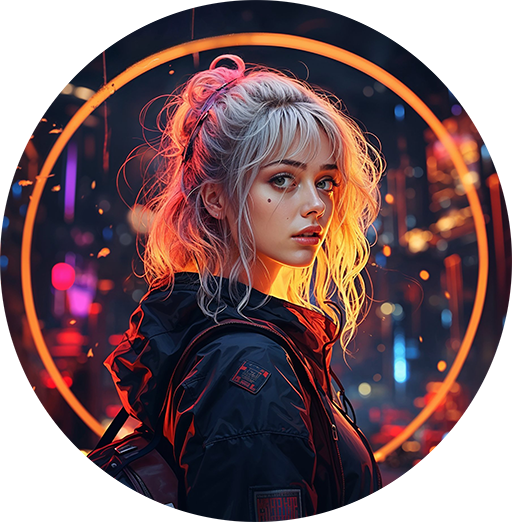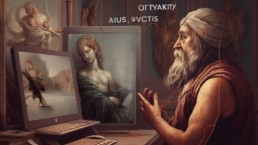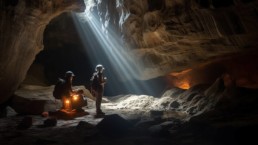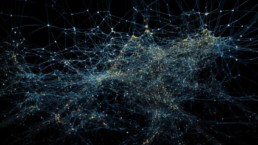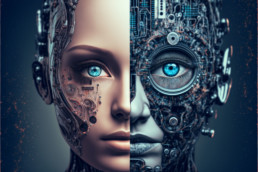Digital Art: Debunking Myths
In recent years, digital art has become increasingly popular, yet it is still surrounded by numerous misconceptions and questions. As artists explore the fusion of art and artificial intelligence, it is essential to clarify the meaning of digital art, address common concerns, and emphasize its value in today’s creative landscape.
Understanding Digital Art
Digital art refers to any form of artistic expression that uses digital technology as an integral part of the creation, manipulation, or presentation process. It encompasses various styles and techniques, ranging from digital painting and illustration to photography, 3D modeling, and interactive installations.
Debunking Myths and Addressing Concerns
Digital art is real art: Some argue that digital art is not “real art” because it does not involve traditional mediums like paint, canvas, or sculpting materials. However, digital art is simply another medium that allows artists to express their creativity and emotions, just like traditional art forms.
Digital art isn’t inherently better or worse: The quality of an artwork depends on the artist’s skill and creative vision, regardless of the medium used. While digital tools may offer convenience and efficiency, traditional art techniques have their own unique charm and tactile qualities.
Digital art is not cheating: The use of digital tools does not automatically make art creation easier or less authentic. Digital artists still need to develop their skills, hone their craft, and invest time and effort into their work.
Exploring the World of Digital Art
Where to find digital art: Digital art can be found in various places, such as online galleries, social media platforms, digital museums, and even physical exhibitions showcasing digital prints or interactive installations.
The future of traditional and digital art: While digital art continues to grow in popularity, it is unlikely to replace traditional art completely. Both forms of art have their own distinct value and appeal, and the two can coexist, enriching the overall creative landscape.
Protecting digital art: Digital art can indeed be copyrighted. Just like traditional art, digital creations are protected by intellectual property laws, allowing artists to safeguard their work from unauthorized use or reproduction.
Digital art is a diverse and fascinating realm that offers new opportunities for artists to explore and express their creativity. By understanding its true potential and addressing common misconceptions, artists can embrace digital art as a valuable and legitimate form of artistic expression.
Art-AI: Exploring the Uses of ChatGPT
As the intersection between art and artificial intelligence continues to evolve, ChatGPT emerges as a revolutionary AI language model that offers countless possibilities for creative minds. With its advanced capabilities, artists and individuals in the creative field can leverage the power of ChatGPT to elevate their work, streamline their processes, and unleash their full artistic potential.
Understanding ChatGPT
ChatGPT, developed by OpenAI, is a highly advanced language model based on the GPT-4 architecture, which utilizes reinforcement learning from human feedback (RLHF) for continuous improvement. This state-of-the-art technology allows ChatGPT to comprehend, generate, and engage in conversational dialogue, making it an invaluable tool for various applications across diverse industries, including the realm of art and creativity.
Expanding the Possibilities for Artists
- Enhanced Virtual Assistants: ChatGPT can be integrated into virtual assistants such as Siri, Alexa, or Google Assistant to offer more personalized and creative suggestions for artists. It can help with tasks like recommending color palettes, finding inspiration for new projects, or suggesting relevant art events and exhibitions.
- Improved Search Functionality: As a search engine tool, ChatGPT can provide artists with more intuitive, natural language-focused search results. This allows artists to explore art-related information, discover new techniques, and find resources for their projects more efficiently and effectively.
- Creative Content Generation: ChatGPT’s remarkable language generation capabilities enable it to craft engaging content such as blog posts, social media captions, and even descriptions for art pieces. This can help artists save time, generate ideas, and maintain a consistent online presence.
- Collaborative Artwork: Artists can harness ChatGPT’s language capabilities to create collaborative pieces, such as poetry or written narratives, that complement their visual art. The AI model can be used to develop unique stories or concepts, sparking new ideas and expanding the creative process.
- Educational Support: ChatGPT can be utilized as an educational tool, assisting artists in learning new techniques, understanding complex concepts, or exploring the history of art. With its ability to adapt and rephrase explanations based on user feedback, ChatGPT makes learning more engaging and personalized.
- Multilingual Assistance: ChatGPT’s proficiency in multiple languages enables artists to access a broader range of resources, translate their work for global audiences, or collaborate with international peers, thereby breaking down language barriers and expanding creative horizons.
- Coding Support: For artists working with digital mediums or exploring generative art, ChatGPT can provide assistance in writing and debugging code, analyzing security flaws, and crafting proof-of-concept demos. This support helps artists streamline their creative process and focus on the artistic aspects of their work.
ChatGPT’s versatility and advanced language capabilities open up a world of opportunities for artists in the realm of artificial intelligence. By leveraging ChatGPT’s potential, creative minds can revolutionize their art, engage with technology in unprecedented ways, and push the boundaries of human imagination.
AI-Driven Art Collaborations: When Creativity Meets Technology
Learn about groundbreaking collaborations between artists and AI developers that showcase the fusion of human creativity with advanced AI systems.
Art has always been a powerful means of expression, transcending time, and connecting individuals from diverse cultures. As technology continues to evolve, the creative landscape is undergoing a transformation, with artificial intelligence (AI) taking center stage. In this blog post, we’ll explore some of the most innovative AI-driven art collaborations that are redefining the boundaries of creativity and showcasing the incredible potential of merging human ingenuity with advanced AI systems.
The Next Rembrandt Project
The Next Rembrandt Project is a fascinating collaboration between data scientists, engineers, and art historians. By analyzing the works of the Dutch master Rembrandt, the team developed an AI algorithm capable of generating a new painting that mimics his style. The result was an impressive AI-generated portrait that captured the essence of Rembrandt’s artistic brilliance, demonstrating the potential of AI-driven art to pay homage to the greats while pushing the boundaries of creativity.
AICAN: AI-Assisted Abstract Art
AICAN is an AI-driven art project developed by Rutgers University’s Art and Artificial Intelligence Lab. The AI system was trained on thousands of pieces of abstract art and then tasked with creating its own unique pieces. In collaboration with human artists, AICAN’s output has been showcased in numerous exhibitions, demonstrating the remarkable synergy between human creativity and AI-generated art.
Google’s DeepDream: A Psychedelic Journey
Google’s DeepDream is an AI project that has captured the imagination of artists worldwide. By using neural networks to analyze and reinterpret images, DeepDream generates surreal and dreamlike visuals that have inspired countless collaborative projects. Artists have used DeepDream’s unique output to create otherworldly works of art, blending human creativity with the power of AI to push the boundaries of artistic expression.
Obvious Art’s AI-Generated Portraits
Obvious Art, a French art collective, has made headlines with its AI-generated portraits, which have even been auctioned off at prestigious art events. By training their AI model on historical portraits, the team successfully generated strikingly original artworks that challenge our understanding of what constitutes art. These AI-driven creations highlight the incredible potential of blending human artistic vision with AI technology.
The Art and Artificial Intelligence Festival In Leicester
The Art-AI is an annual event that celebrates the intersection of art, technology, and AI. Artists and developers from around the world come together to showcase their innovative projects, demonstrating the remarkable collaborations that result when human creativity meets AI-driven technology. The festival provides a platform for exploration and discussion, inspiring future generations of artists to embrace the power of AI in their work.
As AI continues to advance, the possibilities for AI-driven art collaborations are virtually limitless. These groundbreaking projects demonstrate the power of merging human creativity with advanced AI systems, resulting in a new form of artistic expression that is both innovative and awe-inspiring. By embracing the fusion of technology and art, we can expand our understanding of creativity and unlock new realms of artistic potential.
Ethics and Copyright in AI-Generated Art
Explore the challenges and implications of copyright and ownership in the realm of AI-generated art, and how artists and organizations can protect their creations.
AI systems learn from vast amounts of data, including copyrighted material, there is a risk that these systems might generate art that too closely resembles pre-existing works.
As AI-generated art becomes increasingly popular, artists and organizations face new challenges in navigating the legal landscape surrounding copyright and ownership. This growing field raises ethical questions and implications that are essential to address to ensure the protection of both human creators and AI-generated works.
One of the primary concerns in AI-generated art is determining the ownership of the final piece. Traditionally, copyright law awards ownership to the creator of a work. However, in the case of AI-generated art, it is unclear whether the artist who provides the input, the AI developer, or even the AI itself should be considered the creator.
Another challenge lies in the potential for AI-generated art to inadvertently infringe upon existing copyrights. As AI systems learn from vast amounts of data, including copyrighted material, there is a risk that these systems might generate art that too closely resembles pre-existing works. This issue highlights the importance of developing methods to ensure that AI-generated art remains original and does not violate copyright laws.
To navigate these challenges, artists and organizations need to stay informed about the latest developments in copyright law and consider implementing agreements that clearly outline the rights and responsibilities of all parties involved. This may include contracts between artists and AI developers, ensuring that the ownership of AI-generated works is clearly defined.
Additionally, artists should consider registering their AI-generated works with copyright offices to establish a legal record of their creations. This process can help protect artists from potential infringement claims and provide a basis for legal action should disputes arise.
As AI-generated art continues to evolve, it is crucial for artists and organizations to stay informed about the changing legal landscape and take steps to protect their work. By understanding the challenges and implications of copyright in this burgeoning field, artists can confidently create and share their AI-generated masterpieces.
AI-Powered Art Tutorial: Transform Famous Musicians into Kids with Midjourney
AI-Powered Art Tutorial: Transform Famous Musicians into Kids with Midjourney
Discover how to recreate your favorite musicians as children using the AI-powered tool Midjourney, which generates images from simple text inputs.
Taylor Swift, Ed Sheeran and Shakira.
💬 [Musician] [age], [Type of shot], [Shot details], studio photography, volumetric lighting, [clothing], [facial expression], [trait], realistic, [Focal Length], expressive, iconic, 4k --ar 2:3
In this mini-tutorial, we’ll focus on transforming famous musicians into their younger selves. Using Midjourney, an AI-powered image generation tool, you can create images of anyone as a child simply by adjusting the text inputs.

💬 Taylor Swift as a kid, portrait, close-up shot, studio photography, volumetric lighting, wearing a dress, smiling, cheerful, realistic, 50mm, expressive, iconic, 4k
In this example, we aim to transform Taylor Swift into a child. You can further customize the image by specifying the outfit colors and background. For simplicity, we’ll let the AI decide those aspects for us.
To generate new versions of the image, press the 🔁 button in Midjourney until you’re satisfied with the result. Let’s try with Ed Sheeran, and notice how the AI offers four different versions (you can re-roll for more options). Select the images that closely resemble the real person and upscale them for better quality.

💬 Ed Sheeran as a kid, portrait, close-up shot, studio photography, volumetric lighting, wearing a t-shirt, smiling, friendly, realistic, 50mm, expressive, iconic, 4k --ar 2:3
And finally Shakira.
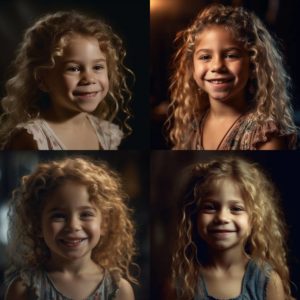
💬 Shakira as a kid, portrait, close-up shot, studio photography, volumetric lighting, wearing a dress, smiling, cheerful, realistic, 50mm, expressive, iconic, 4k --v 5 --s 750
The AI does an impressive job of retaining well-known traits while imagining what the person might have looked like as a child, or exaggerating childlike features. Let’s upscale the first photo.
You can modify the base prompt to transform any known figure into a child. Have fun experimenting with different musicians, adjusting their outfits, and seeing the AI’s imaginative creations.
Convolutional Neural Networks in Deep Learning for Artists
Have you ever wondered how artificial intelligence can recognize and understand images? Convolutional Neural Networks (CNNs) play a significant role in this process. As an artist interested in the intersection of art and AI, it’s important to know the basics of CNNs and how they work. In this blog post, we’ll explore CNNs and their applications in a simple and easy-to-understand way.
What are Convolutional Neural Networks?
Convolutional Neural Networks (CNNs) are a type of deep learning model used in computer vision tasks, such as recognizing objects in images and videos, locating specific items within a scene, or dividing an image into meaningful segments for further analysis.
CNNs consist of multiple layers that work together to extract features from input data and make decisions. These layers include convolutional layers, which apply filters to the input data and extract relevant patterns, pooling layers that downsample the output to reduce computational cost, and fully connected layers that help with classification or prediction tasks.
Some applications of CNNs include facial recognition, self-driving cars, medical image analysis, and even natural language processing.
How do CNNs work?
A CNN processes input data, such as an image, through a series of steps:
- Input layer: The input layer takes raw data, like an image or a video, and sends it to the next layer for processing.
- Convolutional layer: This layer applies a collection of filters to extract features like edges, corners, and forms from the input data.
- ReLU layer: A rectified linear unit (ReLU) activation function is used to add non-linearity to the output and improve the network’s performance.
- Pooling layer: This layer reduces the dimensionality of the feature maps created by the convolutional layer, usually by taking the maximum value in each patch.
- Fully connected layer: This layer takes the output of the pooling layer and applies a set of weights to produce the final output, which can be used for classification or prediction tasks.
For example, when classifying images of cats and dogs, a CNN would go through these steps to identify whether the input image is of a cat or a dog.
Types of CNNs
There are several types of CNNs, including traditional CNNs, recurrent neural networks, fully convolutional networks, and spatial transformer networks. Each type has its unique characteristics and applications in computer vision tasks.
Advantages of CNNs
CNNs are popular for computer vision tasks due to their:
- Translation invariance: The ability to recognize objects in an image regardless of their position.
- Parameter sharing: Reducing the number of parameters in the network, allowing it to generalize better to new data.
- Hierarchical representations: Learning features at various levels of abstraction.
- Resilience to changes: Adapting well to changes in lighting, color, and small distortions in the input image.
- End-to-end training: Allowing for faster convergence and optimized network performance.
Disadvantages of CNNs
Despite their many advantages, CNNs have some drawbacks:
- Lengthy training time: CNNs can be computationally expensive, especially with large data sets.
- Need for large labeled data sets: CNNs require a lot of labeled data to train effectively.
- Susceptibility to overfitting: CNNs can become too specialized to the training data, performing poorly on new, untrained data.
- Limitations in tasks requiring contextual knowledge: CNNs may not be as successful in tasks like natural language processing, which require more contextual understanding.
In conclusion, understanding CNNs can be helpful for artists working with AI and computer vision.
Understanding Robotic Perception in Artificial Intelligence
Robotic perception refers to the ability of robots to sense and understand their environment. This is a critical component of artificial intelligence and plays a key role in enabling robots to perform tasks in a variety of settings. Whether it’s detecting obstacles, recognizing objects, or locating landmarks, the ability to perceive and understand the environment is essential for robots to function effectively.
One of the main challenges of robotic perception is that the environment can be highly dynamic and uncertain.
Robots must be able to adapt to new situations, deal with changing conditions, and overcome unexpected obstacles. To achieve this, robotic perception systems often rely on a combination of sensors, algorithms, and machine learning techniques to process and analyze data.
There are several different types of sensors that are commonly used in robotic perception, including cameras, LiDAR, radar, and sonar. Each type of sensor has its own strengths and weaknesses and can be used to capture different aspects of the environment. For example, cameras are often used to detect and recognize objects, while LiDAR is commonly used to create a 3D map of the environment.
Machine learning is also a key component of robotic perception. With the ability to learn from data, robots can gradually improve their understanding of the environment and become better at detecting and responding to objects and obstacles. In addition to machine learning, robotic perception systems also often use computer vision techniques to analyze images and detect objects and landmarks.
The robotic perception is a critical component of artificial intelligence that plays a key role in enabling robots to sense and understand their environment. Whether it’s through the use of sensors, algorithms, or machine learning, robotic perception systems are essential for robots to function effectively and perform a wide range of tasks. Whether you’re a researcher, developer, or just interested in robotics, understanding the basics of robotic perception is an important step in advancing the field of artificial intelligence.
Artificial Intelligence: A Game Changer for Human Life and the Future
Artificial Intelligence (AI) is one of the most exciting and rapidly evolving technologies of our time. With the potential to transform industries, improve our lives, and shape the future, AI is a topic of great interest and discussion. However, as with any new technology, there are both pros and cons to consider.
On the one hand, AI has the potential to revolutionize industries, improve efficiency, and solve complex problems. For example, AI is being used in healthcare to improve patient outcomes, in finance to prevent fraud, and in transportation to optimize routes. In the future, AI may even play a critical role in addressing global issues such as climate change and poverty.
On the other hand, there are also concerns about the impact of AI on employment, privacy, and security. For example, as AI becomes more advanced, there is a risk that it could replace human workers, leading to unemployment. There are also concerns about the use of AI for surveillance and the potential for AI systems to be hacked or used maliciously.
Despite these concerns, it is clear that AI will play a major role in shaping the future. In the coming years, AI technology is expected to continue to advance, and we will see increasingly sophisticated AI systems in a wide range of industries.
It is estimated that within the next decade, AI will be fully integrated into many areas of our lives, from our homes and workplaces to our healthcare and entertainment.
In conclusion, Artificial Intelligence is a game changer for human life and the future. While there are pros and cons to consider, it is clear that AI will play a major role in shaping the future. As technology continues to advance, it will be important to stay informed and engaged in the conversation about the impact of AI on society, and to work together to ensure that AI is developed and used in ways that benefit all of humanity.
AI Photography: Challenging Our Perception of Reality
The rise of AI technology has brought about many changes in various industries, and photography is no exception. With AI photography, the line between what is real and what is fake has become increasingly blurred. This has sparked a debate on the significance of authenticity in photography and the impact that AI technology has on the art form.
Artificial intelligence is being used to enhance photos, manipulate images, and even create entirely new images from scratch.
This technology can produce highly realistic images, making it difficult to distinguish between what was captured in a camera and what was created in a computer.
While AI photography has the potential to revolutionize the industry and open up new possibilities for artists, it also raises questions about the ethics of using AI in photography. Is it acceptable to use AI to create images that are not entirely real? And if so, should these images be labeled as such?
On one hand, AI technology has the potential to increase access to photography and democratize the art form. For example, AI can be used to recreate images of historical events or moments that were never captured in photographs. However, there is also the risk that AI photography could be used to deceive or manipulate the public, blurring the line between truth and fiction.
The debate on the significance of authenticity in AI photography is ongoing and will likely continue to evolve as the technology progresses. Regardless of one’s personal opinion on the matter, it is clear that AI photography is challenging our perception of reality and forcing us to rethink the meaning of authenticity in the digital age.
In conclusion, AI photography is a fascinating and complex topic that raises important questions about the role of technology in the art form and the impact that it has on our understanding of reality. As the use of AI in photography continues to grow, it will be important to carefully consider the ethical and philosophical implications of this technology.
Yes! an AI is able to change its own trajectory as per the external conditions
Yes, AI systems can be designed to change their own trajectory based on external conditions. This is often referred to as “adaptive” or “online” learning, where the AI system can continuously learn from new data and adjust its behavior accordingly.
There are several types of AI systems that can change their own trajectory based on external conditions, such as:
- Reinforcement Learning (RL) agents: RL agents learn by interacting with an environment and receiving feedback in the form of rewards or penalties. They can adjust their behavior based on the rewards or penalties they receive, and thus change their trajectory over time.
- Adaptive Systems: These systems use machine learning algorithms to continuously learn from new data and adjust their behavior accordingly. For example, an adaptive control system might adjust the settings of a machine based on sensor data in order to optimize performance.
- Evolutionary Algorithms: These are a subset of AI systems that uses evolutionary computations to optimize the parameters of a model, allowing it to adapt to changing conditions.
- Self-adaptive Systems: These systems use a combination of techniques such as machine learning, control theory, and optimization to automatically adjust their behavior in response to changes in their environment.
The ability of an AI system to change its own trajectory based on external conditions depends on the complexity of the problem, the quality of the data, and the design of the system itself.
A few examples of AI systems that can change their own trajectory based on external conditions:
- Self-driving cars: Self-driving cars use a combination of sensors, such as cameras and lidar, to perceive the environment and machine learning algorithms to make decisions about how to navigate. These cars are able to adapt their trajectory in real-time based on the traffic and road conditions, such as changing traffic lights, pedestrians, and other vehicles.
- Adaptive control systems: These systems are used in manufacturing, aerospace, and other industries to optimize the performance of machines and processes. For example, an adaptive control system might adjust the settings of a machine based on sensor data in order to optimize performance and minimize downtime.
- Robotics: Robots equipped with machine learning algorithms can adapt their behavior to new tasks, such as grasping objects or navigating in unknown environments. For example, a robot arm might learn to adjust its grip strength based on the shape and weight of the object it is picking up.
- Adaptive gaming: Games that use AI can adapt to the player’s behavior and adjust the difficulty level accordingly. For example, an adaptive game might adjust the difficulty of the opponents based on the player’s performance, making the game more challenging as the player improves.
- Adaptive financial trading: AI-powered financial trading systems can change their own trajectory by adjusting their strategies in response to market conditions. For example, a trading algorithm might adjust the frequency of trades based on the volatility of the market.
- Adaptive personalization: AI-powered systems can adapt their behavior in response to user preferences, for example, a recommendation engine might adjust the recommended items based on a user’s browsing and purchase history.
These are just a few examples of AI systems that can change their own trajectory based on external conditions, there are many other possible applications, as the technology continues to advance, new possibilities will arise.
